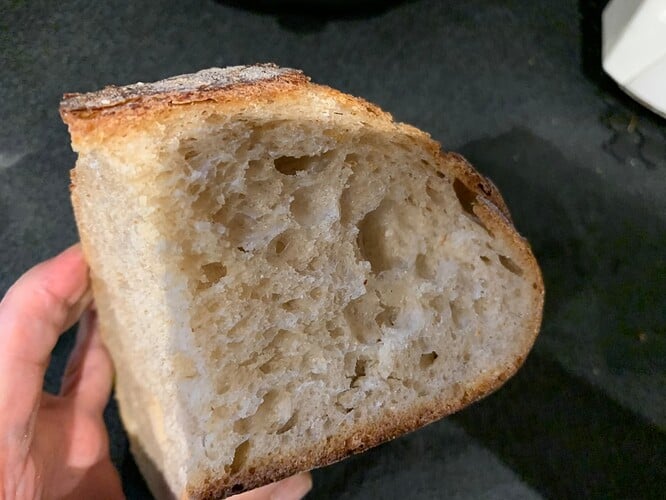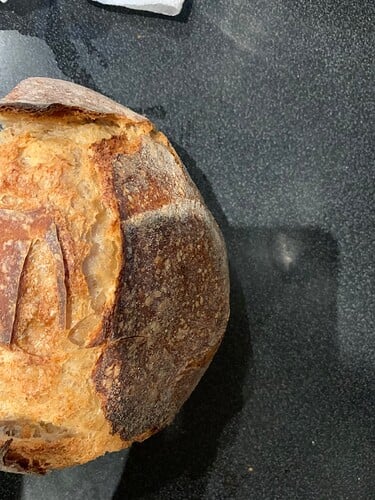I’ve been following the Tartine recipe. I make half, let it rise in the fridge overnight, and bake it in a double cast iron pan that has been heated to 500, and then lowered to 450… The bread looks beautiful, dark gold, and high, but when I cut into it, it’s damp inside. If I cut the loaf in half and let it dry, the halves have risen beautifully, with lots of holes. I’ve tried baking it longer with the top on (45 minutes instead of 30), and another time, longer with the top off, but each loaf is still damp inside. Help!!
It could be a couple things but first- How long are you waiting till you slice into the loaf?
Anywhere from 3 hours to overnight, always with the same result.
Have you tried cutting back on your hydration or added water. Some of my flour, even though same type, takes a different amount of water. Not sure why but thinking it could be the something to do with the grinding of the seeds.
I’ll try that with the next loaf. The bread looks beautiful, and once I cut it in half and dry the damp halves, the slices are beautiful, with large holes.
Any luck with the previous suggestion?
If you have a temperature probe, it could be helpful to take a temperature reading of the internal dough temperature, when you think the bake has completed. I tend to look for this temp range 190–210°F [88–99°C]. Got the temp range from this article https://blog.thermoworks.com/bread/sourdough-bread-times-and-temperatures.
The temperature is always around 209 to 210. I tried using 10 grams less water. Same disappointing result: beautiful-looking well risen loaf that’s damp inside. When I halve it (with some difficulty since being damp it resists the bread knife) and let each half dry, the slices then look lovely with lots of holes.
@joan.cassell Joan, I have found that with some of my recipes I need significantly less water than originally called for in the recipe especially depending on what kind of flour I’m using. In my humble opinion, you might consider using even less water in your next loaf. Reducing the amount of water by 10 grams may not be enough of a reduction. An illustration would be what I have to do with one of my recipes I had to modify due to dietary restrictions: as written the recipe calls for 400 grams water. Because I had to change the type of flour I’m using, I had to reduce the water to 325 grams! While that seems like a large reduction in water, and I suppose it is substantial, the resulting loaves come out perfect!
You might consider reducing the amount of water by 30-50 grams when preparing your next loaf. As your mixing the dough together, if it seems too dry or if all the flour isn’t mixing in easily enough, simply add 5-10 grams of water into the dough and continue mixing. You can always add a bit more water. Too much water and the dough’s fate is sealed. As soon as all the flour has absorbed the water then don’t add any more water. Note how much water you used for that loaf and see how it bakes and slices up. Worst case scenario is that your resulting loaf will be drier than you personally care for, though I suspect it’ll be perfectly edible. Best case scenario is that it’ll be perfect!
Baking blessings,
Leah
I’ll give it a try my next time. It sure is frustrating!
Looking forward to your next test :-). If possible please share some photos.
Side note, but might be relevant… My mom was having problems with hydration and her loaves until I figured out she was following a recipe from someone in a desert; when she essentially lives in a steam sauna.
@j4m3s4j Your side note may be very relevant. I live in the desert southwest. I don’t know where @joan.cassell lives. Good point and not one I thought of.
Leah
Step 1: Ignore the word “recipe”.
I’ve been gradually cutting the water in my Tartine sourdough recipe. The recipe calls for 350 grams of water (I make 1 loaf, not 2) and my last try was 290 grams. The bread is beautiful looking with great oven spring (209 degrees when I removed it) but it’s still damp. When I cut it in half, with some difficulty, and dry the halves, the bread tastes delicious. What am I doing wrong?
Can you post a photo of the crumb? When you say damp do you mean gummy? Could be a sign of under fermented.
Here’s the bread after being cut in half and dried for a few hours. It tastes delicious! But it needs to be dried before I can easily slice it. (I’m afraid I don’t know what “underfermented” means, sigh…
Doesn’t look too bad. Actually looks very good. That’s the good news. Bad news is the dampness is still a mystery.
Might be slightly under fermented but doesn’t look like enough to cause gumminess. But I’m being overly pedantic because of the issue.
As an experiment can you try repeating the recipe all at room temperature? Follow the method which doesn’t include any fridge time.
Curious to see where it’s going wrong.
Sure, I’ll do it the next time around, I won’t refrigerate it overnight and I’ll use 290 rather than 350 grams of water, as I did this time. This may be in a week or two, when I finish this loaf (since I’m the only one who eats it).
I agree with Abe, the crumb doesn’t look particularly under fermented. Another thing you could try is to leave the loaf in the oven at the end of bake, oven then turned off for another 5-15 minutes. This might allow the crumb to more fully dry out.
My daughter spoke to some professional bakers she knows about this, and one said that when she lived in Saint Louis (where I live) she had all sorts of problems with her baking that she’d never had before. (This is reassuring but no solution.)
Perhaps its the local flour. Have you tried changing brand? Which flour do you use?

